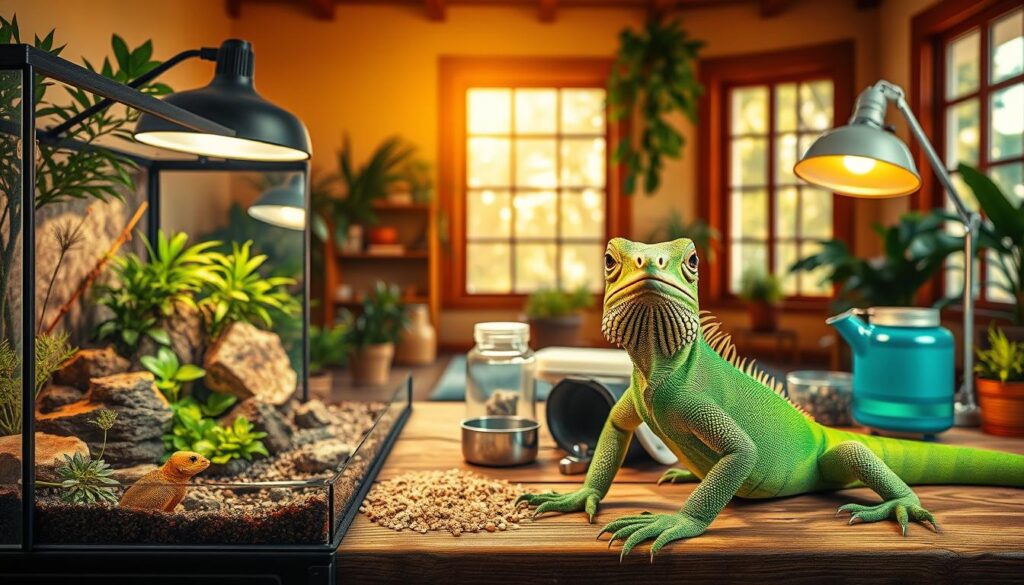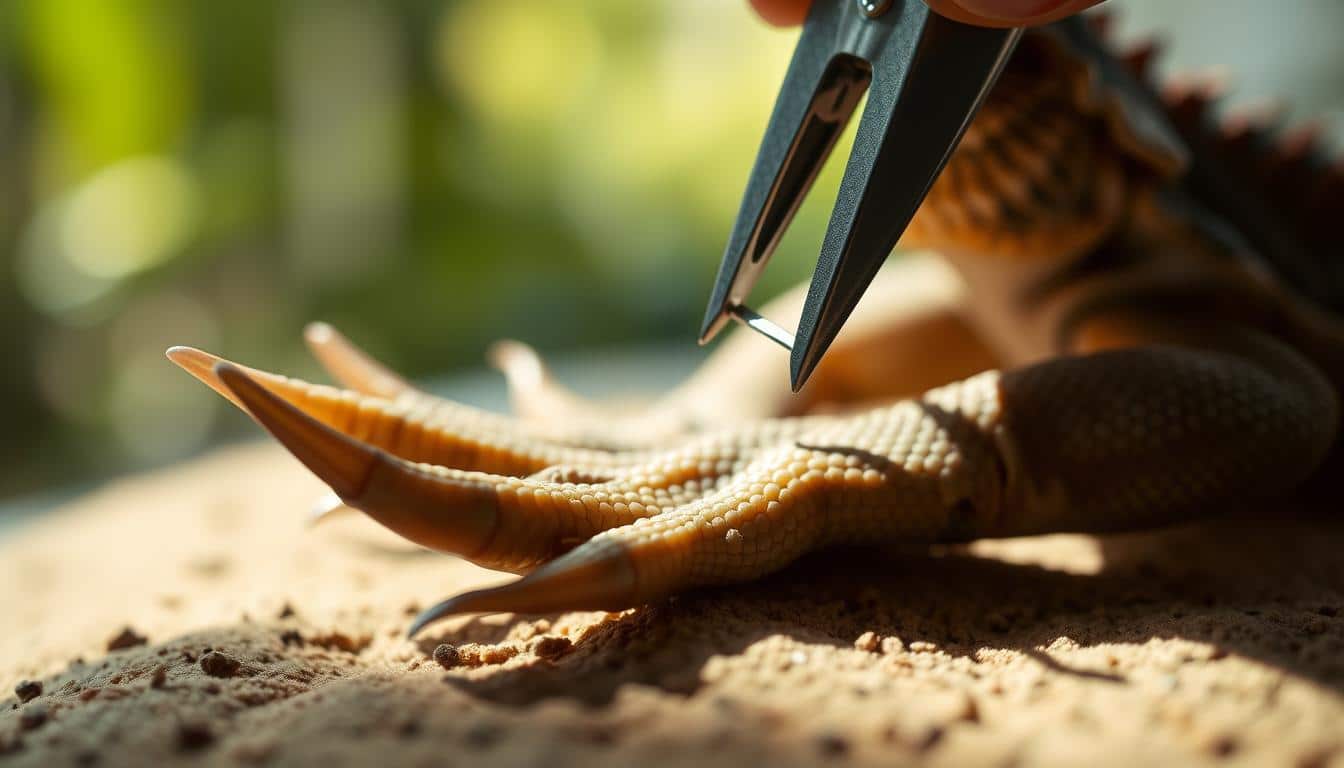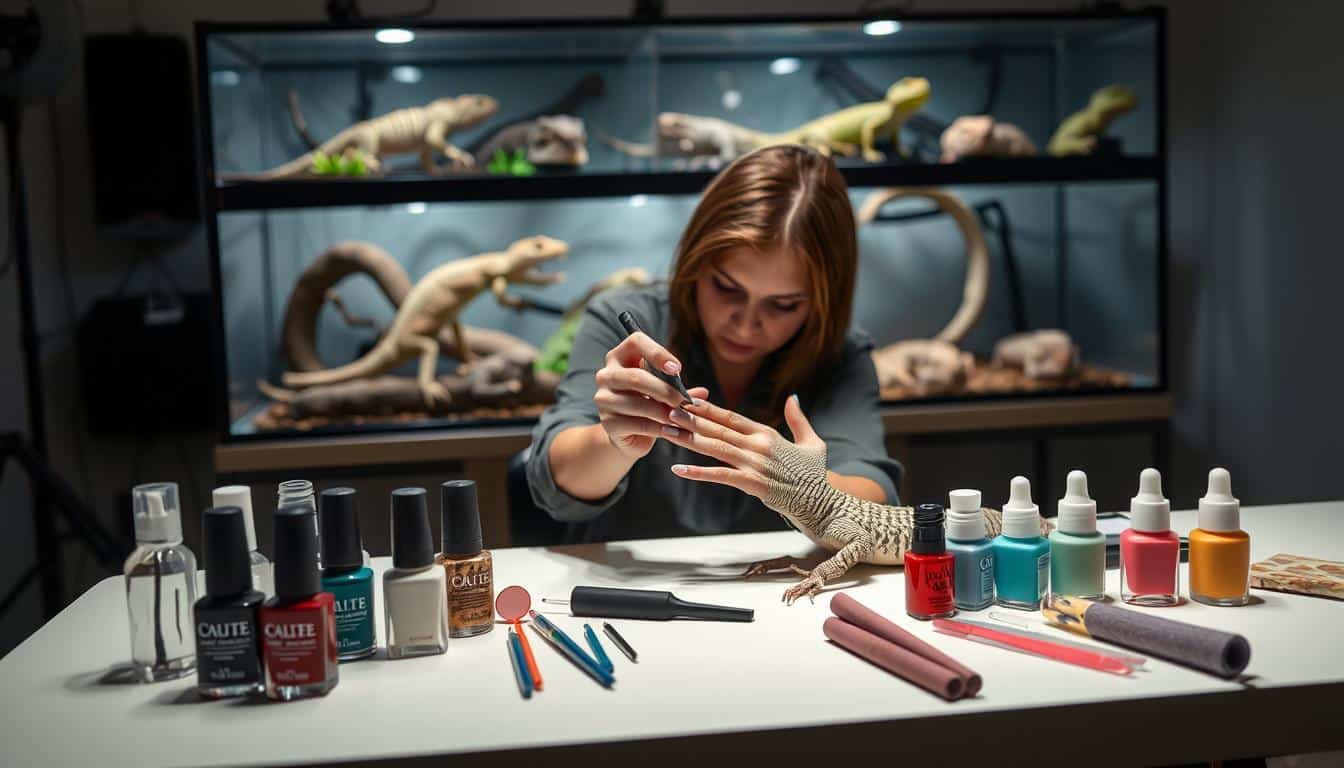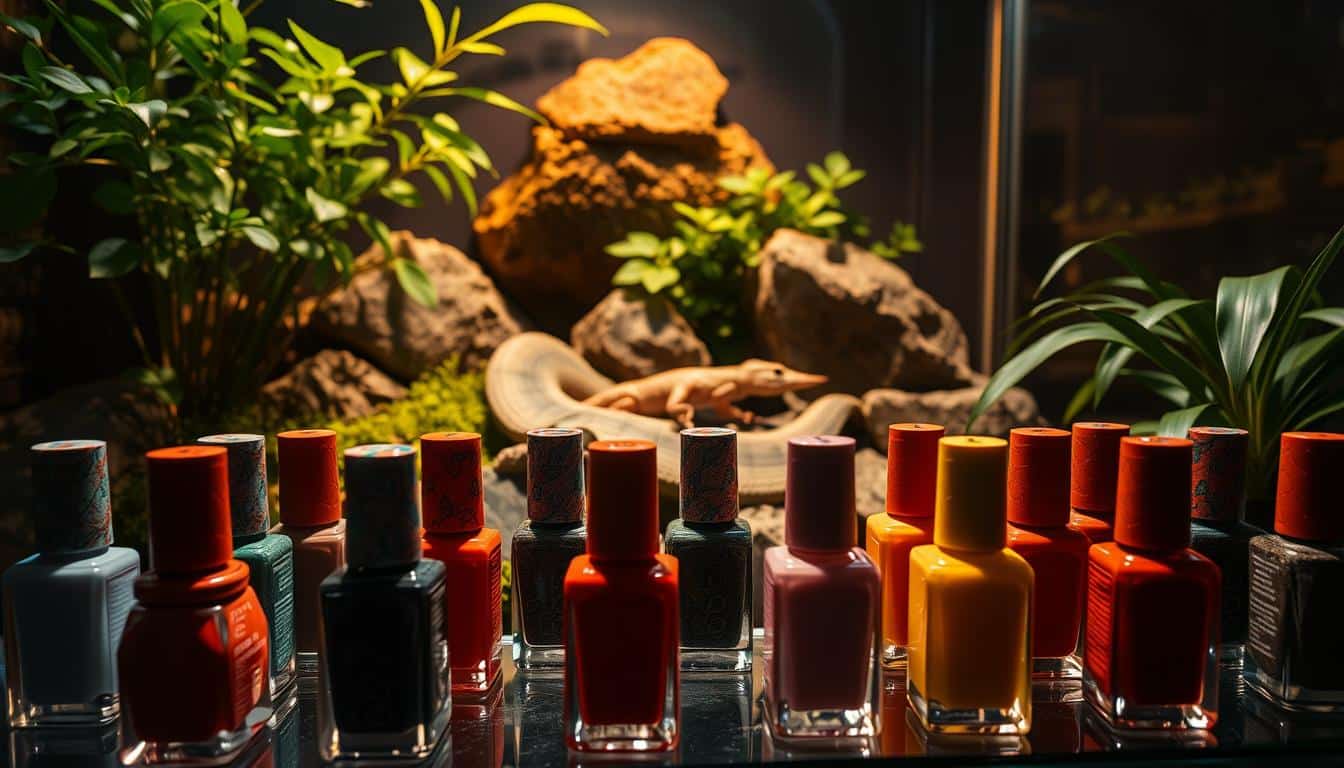Anúncios
Welcome to the ultimate guide on taking care of reptile leather. Whether you’re new or experienced in reptile ownership, learning about polish and scales is key. Your exotic leathers will last longer and look better if you know how to care for them. This article will teach you the right way to look after lizard skin products.
If you love reptile leather, keeping it healthy is important. We will cover everything from the traits of different skins to the top care tips for lizard skin. Our guide will give you all the tools and tips you need. Let’s dive into the dos and don’ts of caring for reptile leather to keep your items in great shape.
Introduction to Reptile Care
To keep reptiles healthy, proper care is crucial. An intro to reptile care gives owners key tips to create a healthy space for their pets. Because reptiles are special, they need specific care that matches their unique needs. This includes keeping the right temperature, the correct level of humidity, and knowing what food is best.
Healthy reptiles mean better-quality skin for making leather goods. Taking good care of reptiles helps both the animal and the leather made from them. By focusing on good care methods, owners help their reptiles and the products made from them last longer.

Understanding Your Reptile’s Skin Type
Knowing about different reptile skin types helps you look after them better. Reptiles like lizards, snakes, and crocodiles have unique skin that needs special care. When you understand these differences, you can keep your reptile healthy and looking great.
Differences Between Types of Reptile Skins
Reptile skins are quite diverse and this affects how you take care of them. Each kind has its own challenges and benefits.
- Lizard Skin: Lizard skin is waterproof and tough. But, it needs gentle cleaning to avoid hurting the scales.
- Snake Skin: Snake skin stands out with its beautiful patterns. It’s fragile and needs to be handled with care. For keeping snake skin in good shape, use soft cleaners.
- Crocodile Leather: Crocodile leather is known for its strength. Yet, it can dry out and crack if not cared for properly. To keep crocodile leather good as new, use conditioners regularly.
Specific Care for Lizard, Snake, and Crocodile Skin
Different reptile skins require different care. To care for lizard skin, wipe it down gently with a soft cloth and a reptile-safe cleanser. Keeping snake skin in tip-top shape means cleaning it gently and not too often, while avoiding strong chemicals. This helps keep its look and feel. Crocodile leather needs special conditioners to stay hydrated but still look natural.
Polish & Scales: The Dos and Don’ts for Reptile Owners
Knowing how to take care of reptiles is important for their health. By following good practices, you make sure they live in a safe environment. Avoiding mistakes helps prevent health problems. Let’s look at the important dos and don’ts for keeping these unique pets healthy.
Essential Dos for Maintaining Reptile Health
- Regularly clean your reptile’s habitat with the right products to stop harmful bacteria from growing.
- Use special conditioners for exotic leathers to keep their scales looking natural and healthy.
- Always check the temperature and humidity, as they’re key for keeping your reptile well.
- Give them a balanced diet that fits their species and always have fresh water ready.
Critical Don’ts to Avoid Damage
- Stay away from strong chemicals that could hurt your reptile’s skin and scales.
- Not paying attention to sensitive areas could cause serious damage or health issues.
- Keeping too many reptiles in one space can stress them out and make them sick.
- Don’t feed them common insects that are bad or not meant for their diet.
Importance of Regular Conditioning
Keeping exotic leather in top shape is key for anyone into reptile care. The right exotic leather conditioners keep items soft and good-looking. It’s important to pick a conditioner made just for reptile leather to get the best results.
Choosing the Right Conditioner for Exotic Leathers
Finding a suitable conditioner is very important. For example, Saphir Reptan with lanolin oil works well without soaking too much into the skin. This helps keep the natural feel and stops it from drying out.
Application Techniques for Optimal Results
How you apply conditioner matters a lot for good results. Here are some tips:
- Apply a thick layer of the conditioner to allow for deep penetration.
- Ensure that the leather is clean before application to maximize absorption.
- Allow the conditioner to soak in for an extended period, preferably overnight, for best results.
- Buff the leather gently after the absorption time to restore its natural shine.
Cleaning Your Reptile Leather Products
Keeping your reptile leather in top shape takes careful cleaning practices. The right methods make sure it lasts long and keeps its quality. Below are tips for both spot and deep cleaning to keep your items looking great.
Safe Products for Spot Cleaning
To clean reptile leather without harm, using safe products is key. Start with a soft, slightly damp cloth for spots. Always wipe in the scale direction to avoid damage. Here are some good cleaning solutions:
- Distilled water with a bit of mild soap.
- Special reptile leather cleaner without alcohol.
- Wax-free, natural oil-based products.
Deep Cleaning Methods for Stubborn Stains
For tough stains, you might need deeper cleaning. Use a non-alcoholic, wax-free cleaner. Always do a patch test on a small, hidden area first. Follow these steps for deep cleaning:
- Gently apply the cleaner with a soft cloth in circular motions.
- Let the cleaner sit briefly before wiping it off.
- Dry the item in an airy spot, away from direct sunlight.
Protection Against Elements
Keeping reptile leather safe from weather is key to its beauty and long life. You need to understand how water resistance and moisture play a part.
Water Resistance and Its Importance
Water resistance is vital for reptile leather’s health. Even if leathers like lizard skin can handle some water, too much can hurt them. This might make scales fall off or change color.
It’s important for owners to know how to protect their leather in the rain. This keeps it from getting damaged.
How to Handle Exposure to Moisture
Dealing with water means being quick to act. If your leather gets wet, here’s what to do right away:
- Use absorbent cloths to blot moisture rather than wipe, which can cause scratches.
- Apply a water-resistant protectant designed specifically for exotic leathers after cleaning.
- Avoid prolonged exposure to wet environments, which can lead to irreversible damage.
By following these steps, your reptile leather will stay looking great. Plus, you’ll keep its unique look without too much hassle.
Addressing Wear and Tear
Keeping reptile leather in good shape is crucial for its look and life. Signs like cracked scales, less shine, and changes in texture mean it’s time for care. Catching these signs early helps stop more damage.
Signs That Your Reptile Leather Needs Attention
You should watch for certain signs to keep your reptile leather looking great. Keep an eye out for:
- Cracks or splits in the leather
- Diminished shine or luster
- Visible changes in color
- Rough textures or peeling
These are clues that your reptile leather needs some TLC to stay beautiful.
How to Repair Common Problems
Fixing small issues can be easy. For minor damage, try these steps:
- Use high-quality conditioners to make the leather soft and shiny again.
- Apply pigmented creams to cover any color changes or scratches.
Taking care of these problems right away helps your reptile leather items last longer and look better.
Storage Solutions for Reptile Leather
Proper storage keeps reptile leather in top condition for a long time. It’s important to make a good environment for it. This means keeping it looking and working great for many years.
Best Practices for Long-Term Care
Keep these tips in mind for storing reptile leather:
- Use breathable containers to prevent moisture buildup.
- Store in a cool, dark, and dry spot to avoid damage from the surroundings.
- Don’t stack items or put heavy things on the leather to keep its shape.
- Check it often for any wear or damage to fix it early.
Environment Considerations for Storage
Choosing the right storage environment is key for reptile leather. Aim to keep it away from too much heat and moisture. This helps the leather last longer:
- Keep the temperature steady without big changes.
- Maintain low humidity to prevent mold and mildew.
- Make sure there’s enough air moving around the leather.
Using the Right Tools for Maintenance
Selecting the right tools for reptile leather care is very important. Suitable brushes and cloths are key for good cleaning and keeping the leather looking great. Picking the best tools also improves how well you can clean and care for the leather.
Recommended Brushes and Cloths
For getting into textured surfaces, medium horsehair brushes are best. They don’t cause damage. Soft, gentle cloths are good for shining and putting on conditioners. Having a set of brushes just for different leather types makes care better.
Products to Avoid in Reptile Leather Care
Some products are bad for reptile leather. Stay away from anything with silicone since it can make the leather dry and less shiny. Knowing what harms the leather helps keep it in top shape and looking beautiful.
When to Seek Professional Help
Knowing when to get professional help for reptiles is key to keeping them healthy and their skin in good shape. Some problems can get worse if you don’t deal with them quickly. If you see serious cracking, skin that isn’t holding together well, or color changes that don’t go away, you might need an expert.
Identifying Major Issues Requiring Expert Attention
Finding problems early can really help your reptiles stay healthy. You should get professional help if you notice:
- Severe or recurring skin cracking
- Obvious changes in skin color that stick around
- Structural problems in leather items that show the inside materials
- A strange smell that could mean mold or decay
Choosing the Right Specialist for Reptile Care
Choosing the right expert for reptile care is critical. Look for someone with a good track record in exotic leather care. This ensures they follow the best practices. When picking your specialist, think about:
- Reading reviews and what past clients have said.
- Asking about their repair techniques and materials.
- Checking their qualifications and experience with reptiles.
- Making sure they offer a service warranty or guarantee.
Popular Misconceptions About Reptile Leather Care
Proper care of reptile leather is often surrounded by myths in reptile care. Many reptile owners think that any leather care product works for exotic leathers. This is not true, as reptile skins are unique and need special care. Knowing how to care for these materials is key.
Deconstructing Common Myths
- Many believe that regular leather conditioners can be used on reptile leather. This is false, as reptile leather requires specially formulated products.
- Some think that more is always better, applying excessive amounts of conditioner, which can actually harm the leather.
- People often assume that reptile leather needs no protection against moisture, which is a misconception that can lead to degradation.
Understanding the Truth Behind Care Practices
Fixing misconceptions in leather care means choosing the right products for reptile leather. These products keep exotic leathers hydrated without damaging them. Learning the correct way to use them helps the leather last longer. By knowing the truth, owners can take good care of their reptile leather confidently.
Conclusion
Taking care of reptile leather well means knowing what it needs and using the right products for it. It’s key to understand how reptile skins vary, to use the correct conditioning methods, and to do regular upkeep. This keeps the leather strong and looking good.
By sticking to these care tips, owners can make their exotic leather items last longer. This is good for both the person and their reptile friends. Keeping up with leather care keeps it in top shape and helps the environment too.
In the end, paying close attention and making smart choices is crucial. This ensures your reptile leather stays beautiful and tough. It also strengthens the special connection with your exotic pets.



